
Procedures
Diagnostic services:
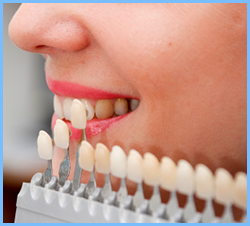 The initial oral examination will include both the visual exam and x-rays.
X-rays help the dentist see what is not visible to the naked eye. This includes cavities, infections, and periodontal disease.
The initial oral examination will include both the visual exam and x-rays.
X-rays help the dentist see what is not visible to the naked eye. This includes cavities, infections, and periodontal disease.
Preventative services: Oral Hygiene/Maintenance: Scalings: 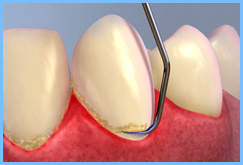 Sometimes a regular cleaning isn't enough to combat periodontal
disease. A scaling (or deep cleaning) is a more thorough cleaning, often
done with the patient being numb. This allows the dental professional to
remove any buildup that developed deep under the gums. It is usually done
once, followed by frequent maintenance cleanings.
Sometimes a regular cleaning isn't enough to combat periodontal
disease. A scaling (or deep cleaning) is a more thorough cleaning, often
done with the patient being numb. This allows the dental professional to
remove any buildup that developed deep under the gums. It is usually done
once, followed by frequent maintenance cleanings. Fillings: Tooth Whitening:  Almost everyone can benefit from teeth whitening in order to remove tooth
discoloration caused by coffee, tea, tobacco, red wine, aging, old
restorations or use of antibiotics.
Using products not available in stores, teeth can be bleached for a brighter
smile. In-office and home-care products available.
Almost everyone can benefit from teeth whitening in order to remove tooth
discoloration caused by coffee, tea, tobacco, red wine, aging, old
restorations or use of antibiotics.
Using products not available in stores, teeth can be bleached for a brighter
smile. In-office and home-care products available.
Veneers: 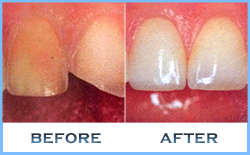 Sometimes teeth cannot be whitened or fixed with traditional fillings.
Veneers are thin porcelain coverings that are permanently cemented to
natural teeth. They are designed to correct teeth that are permanently
stained, chipped, or broken. They are custom shaded to give you a natural
looking, beautiful smile.
Sometimes teeth cannot be whitened or fixed with traditional fillings.
Veneers are thin porcelain coverings that are permanently cemented to
natural teeth. They are designed to correct teeth that are permanently
stained, chipped, or broken. They are custom shaded to give you a natural
looking, beautiful smile.
Invisalign: 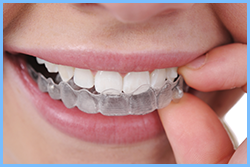 Invisalign straightens teeth without traditional metal or ceramic brackets.
It uses clear plastic trays that are virtually invisible to correct crooked
or crowded teeth, gaps between the teeth, and overbite. Since they are
removable, you can eat whatever foods you enjoy and you can brush and floss your teeth normally.
Invisalign straightens teeth without traditional metal or ceramic brackets.
It uses clear plastic trays that are virtually invisible to correct crooked
or crowded teeth, gaps between the teeth, and overbite. Since they are
removable, you can eat whatever foods you enjoy and you can brush and floss your teeth normally.
Root canals: Crowns: 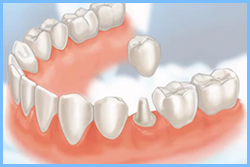 Crowns (also known as caps) are protective or cosmetic coverings for teeth.
Many teeth that have large, unstable fillings are prone to fracturing and
need crowns for protection. They act as helmets to absorb the biting forces
applied to it. Crowns are usually done to restore the function and
appearance of the teeth after root canal treatments or when a large portion
of the tooth is decayed or broken. They are custom made in a lab and are
designed to look beautiful and natural.
Crowns (also known as caps) are protective or cosmetic coverings for teeth.
Many teeth that have large, unstable fillings are prone to fracturing and
need crowns for protection. They act as helmets to absorb the biting forces
applied to it. Crowns are usually done to restore the function and
appearance of the teeth after root canal treatments or when a large portion
of the tooth is decayed or broken. They are custom made in a lab and are
designed to look beautiful and natural.
Bridges: 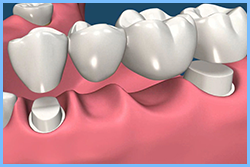 Also known as fixed partial dentures, bridges are mainly used to replace
missing teeth. Using two or more natural (or implant) teeth, several
crowns/teeth are fused together to form a single appliance that is
permanently cemented in place. Made the same way as crowns, the result is
natural and beautiful.
Also known as fixed partial dentures, bridges are mainly used to replace
missing teeth. Using two or more natural (or implant) teeth, several
crowns/teeth are fused together to form a single appliance that is
permanently cemented in place. Made the same way as crowns, the result is
natural and beautiful.
Extractions: Partial dentures: 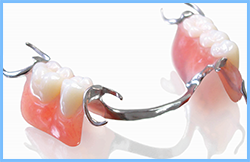 This is a popular option for people missing several, but not all, of their
teeth. Using the remaining teeth for support, a lab custom designs a
removable appliance that replaces all the missing teeth.
This is a popular option for people missing several, but not all, of their
teeth. Using the remaining teeth for support, a lab custom designs a
removable appliance that replaces all the missing teeth.
Full/Complete Dentures: 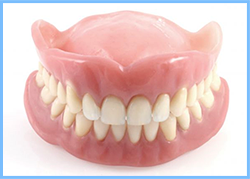 This is a popular option for people missing all
their teeth. A lab uses molds/models to creates a removable appliance that
replaces all the missing teeth in an arch.
This is a popular option for people missing all
their teeth. A lab uses molds/models to creates a removable appliance that
replaces all the missing teeth in an arch.
Dental implants: 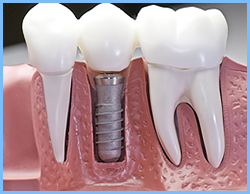 The gold standard in replacing missing teeth. Implants are essentially
titanium screws fused inside the jawbone. Once healed, they can serve as
supports for individual teeth, multiple teeth, and even dentures.
The gold standard in replacing missing teeth. Implants are essentially
titanium screws fused inside the jawbone. Once healed, they can serve as
supports for individual teeth, multiple teeth, and even dentures.
|
 General Information
General Information Procedures
Procedures Gallery
Gallery Testimonials
Testimonials